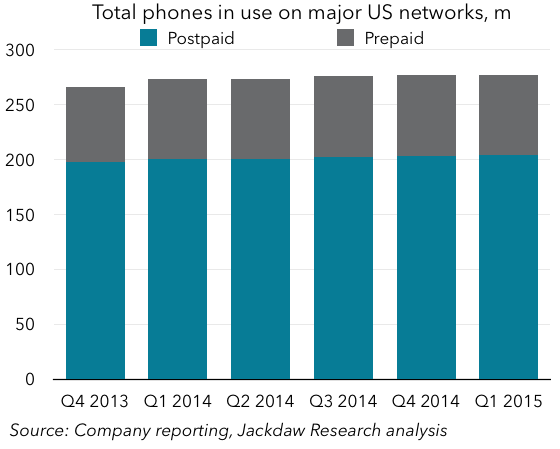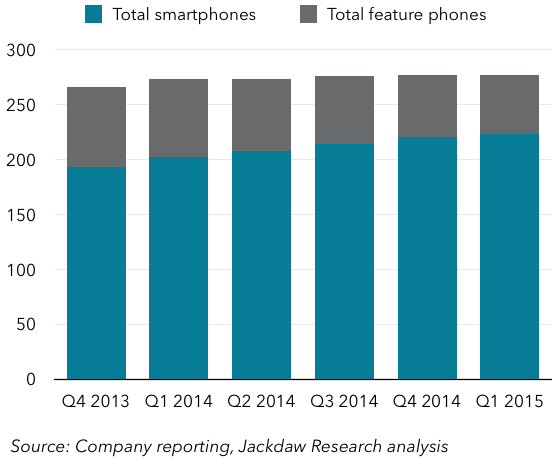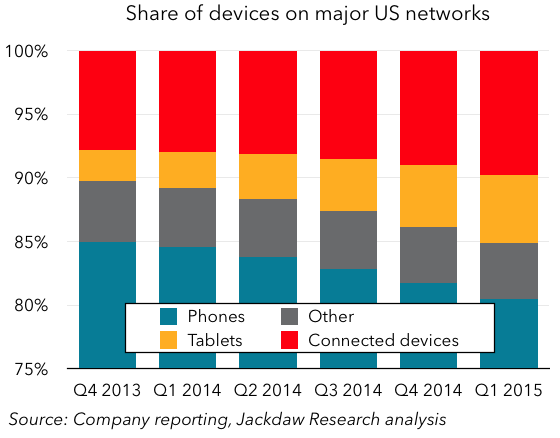For much of the last three decades, the terms “wireless carrier” and “cellphone provider” have largely been synonymous. Your wireless carrier was the company that provided the service for your cellphone, and in the vast majority of cases also sold you that cellphone, often at a heavily subsidized rate. However, the reality is that the wireless carriers in the US are becoming much more than just cellphone providers, and in fact cellphones are becoming a smaller percentage of devices on the major US mobile networks over time.
Phones are growing, but not as fast as in the past
The total number of phones on the four major US mobile networks (AT&T, Sprint, T-Mobile, and Verizon Wireless) continues to grow, but the rate of growth has slowed. Whereas in the past phone subscribers grew by double digits every year, now they grow by single digits at best, and the reason is obvious: the vast majority of people who will ever own a phone already have one.
 The small amount of growth there is in phones comes in large part from the generational effect of new users emerging at the younger end of the population scale, combined with a few laggards and late adopters among the older generations.
The small amount of growth there is in phones comes in large part from the generational effect of new users emerging at the younger end of the population scale, combined with a few laggards and late adopters among the older generations.
From feature phones to smartphones
Within phones, of course, there are still significant dynamics, not least the shift from feature phones to smartphones. Each of the major carriers now reports well over half its base is on smartphones, and around 85-90% of their phone sales each quarter are smartphones too, which means the transition is going to happen very quickly. This is good news for the carriers, because smartphone users are likely to be far heavier consumers of data services, and this in turn drives higher revenue per user. However, it doesn’t drive subscriber growth as such, and as the total number of phones grows more slowly, and competition for those subscribers intensifies, carriers are looking elsewhere for growth.
This is good news for the carriers, because smartphone users are likely to be far heavier consumers of data services, and this in turn drives higher revenue per user. However, it doesn’t drive subscriber growth as such, and as the total number of phones grows more slowly, and competition for those subscribers intensifies, carriers are looking elsewhere for growth.
Growth comes from elsewhere
As carriers seek to maintain growth even as phone growth plateaus, they’ve focused on two other key areas: tablets, and “connected devices”. Connected Devices is the term used by several carriers to describe devices with connectivity which is not sold in traditional ways to consumers, but rather often sold to businesses, whether for their own use in machine-to-machine applications, or as part of a package sold to consumers, whether connected cars, Amazon Kindles, or as part of mobile healthcare solutions. The chart below shows how the percentage of these two categories in the overall subscriber base is increasing, even as phones and other older categories such as mobile broadband modems fall as a percentage:  Phones have fallen several percentage points over the past year, while tablets and connected devices have risen. Between them, these two newer categories now make up just over 15% of total devices on these networks, and they also make up a significant proportion of net subscriber additions for the major wireless operators.
Phones have fallen several percentage points over the past year, while tablets and connected devices have risen. Between them, these two newer categories now make up just over 15% of total devices on these networks, and they also make up a significant proportion of net subscriber additions for the major wireless operators.
Wearables are next
Although tablets are by far the second most prevalent devices on consumers’ service plans today after phones, the next potential category to emerge is wearables. The vast majority of these devices today are only bluetooth or WiFi enabled, without their own cellular connectivity, and rely on tethering to smartphones to be valuable. However, the first generation of cellular-enabled smartwatches is already emerging, and carriers are hoping that these will provide more subscription growth over time. It’s worth noting that these devices won’t have anything like the data consumption patterns of tablets, let alone smartphones, and so the revenue associated with them will be smaller, but over time a portfolio of devices on a consumer’s plan could become a powerful source of revenue for the carriers even as phone growth slows.
Phones the central devices, for now
With all this change, it’s important to note that phones still represent well over half the devices on these networks, and that they’re going to remain the central devices in people’s connected lives, not least because many of the new devices will be adjuncts to them in some way. However, over time, as other devices gain more independence from the smartphone, the center of gravity may begin to shift away from phones and towards other devices, especially wearables. We’re likely several years from that scenario at this point, but it’s already foreseeable on the horizon.